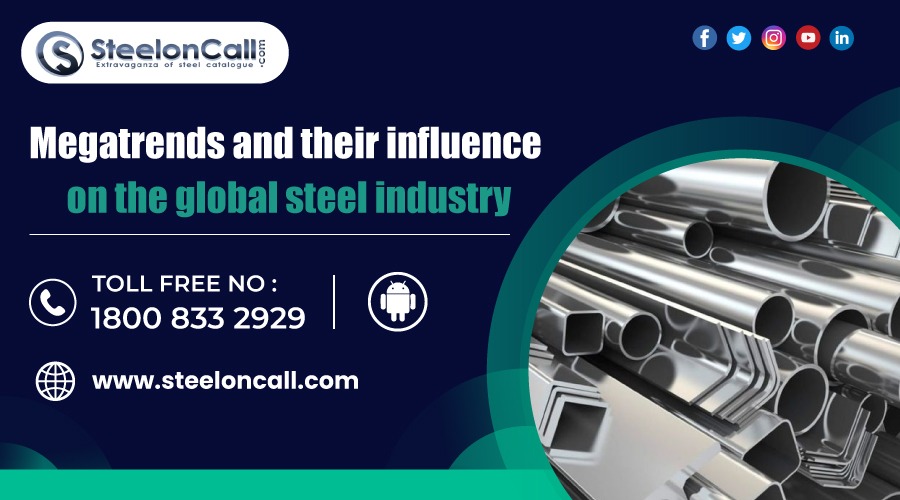Megatrends and their influence on the global steel industry

The global steel and Thermo-Mechanically Treated (TMT) bar industries are experiencing a radical transformation due to megatrends driving their evolution. From adopting cutting-edge technologies to meeting sustainability obligations, these industries find themselves at the crossroads of innovation, challenges, and unique opportunities. Construction materials must provide a balanced combination of strength, durability and flexibility to succeed in today's globalized world. Steel and TMT bars stand out as essential elements of construction that provide essential structural integrity, safety and longevity of buildings.
Here we take an in-depth look at these megatrends that are shaping these industries around the globe.
1. Digitization and Industry 4.0:
Industry 4.0 has introduced the steel industry to a new era of digitalization. Smart manufacturing processes using artificial intelligence (AI), the Internet of Things (IoT), and big data analytics technologies optimize production efficiency, improve quality control measures, and cut operational costs while decreasing operational costs. Global steel mills have enthusiastically welcomed this digital transformation - from automated steel mills to predictive maintenance strategies that minimize downtime.
2. Sustainable Steel Production:
Sustainability has become an essential criterion for industries worldwide as the planet grapples with environmental challenges, and steel sector industries are no exception. Global steel producers are committed to reducing their environmental footprint through eco-friendly practices such as investing in cleaner production processes, increasing energy efficiency, and using recycled materials in production - which align with global initiatives targeting climate change mitigation and circular economies. The quest for sustainable steel is part of this global initiative to promote circular economies.
3. Advanced Manufacturing Techniques:
Digitalization and advanced manufacturing techniques are revolutionizing how steel is produced, opening up endless opportunities in its application across diverse sectors. From lightweight automotive materials to high-tensile reinforcements for construction sites, steel applications have grown immensely over the past several years thanks to these developments.
4. Global Infrastructure Development:
Urbanization and economic expansion have led to an explosion of global infrastructure projects that have directly increased steel demand. Steel is the foundational material that defines modern life, from skyscrapers and bridges to railways and smart cities. Initiatives such as the Belt & Road Initiative in emerging economies as well as plans to upgrade aging infrastructure are fuelling this global steel industry forward.
5. Circular Economy Principles:
The steel industry is transitioning toward circular economy principles, emphasizing recycling and sustainable use of resources. Steel's high recycling rate lends itself well to circular economy efforts; scrap-based steel production has gained ground, decreasing reliance on raw materials and energy. A circular economy approach addresses resource scarcity and positions steel as an environmental steward.
6. Geopolitical Dynamics and Trade:
Geopolitical shifts and trade dynamics exert a powerful impact on the global steel industry, including tensions over tariff policies and regional agreements and their effect on steel flow across borders. To remain profitable and ensure sustainable growth for the future, businesses must manage geopolitical uncertainties by adapting to changing trade landscapes while exploring new markets to ensure stability and growth.
7. Shifting Consumer Preferences:
Consumer preferences are changing, driving demand for more sustainable and responsible products. Steel manufacturers have responded by emphasizing transparency in their supply chains, adopting green practices, and communicating their commitment to corporate social responsibility - changes that impact every step in the steel value chain, from raw material extraction through production to end-user products.
8. Steel Product Innovations:
The global steel industry is witnessing an explosion of product innovation. From advanced high-strength steels and customized alloys for specific uses to meet evolving automotive, construction, and aerospace industry requirements - manufacturers are diversifying their product portfolios while simultaneously positioning steel as a future technology material of choice.
9. Energy Transition and Steel Production:
The push towards renewable energy sources and the transition to a low-carbon economy has severe ramifications for the steel industry. Traditional production processes, particularly blast furnaces, are energy-intensive and carbon-emitting. Alternatives such as hydrogen steelmaking are being explored to align with clean energy goals. However, the transition may present unique challenges and opportunities for sustainable steel production.
10. Resilience Amid Disruptions:
The steel industry has made significant strides to increase resilience against natural disasters, pandemics, or supply chain challenges. Strategies such as diversifying suppliers, adopting digital twin technologies for risk management purposes, and adopting agile production processes have become integral parts of its strategy for mitigating shocks and maintaining continuity.
Conclusion:
Overall, the global steel industry is currently experiencing a profound transformation driven by global megatrends that reach beyond national boundaries. From digitization and sustainability initiatives to geopolitical shifts and consumer preferences, these megatrends are altering their trajectory radically by adapting to them and meeting challenges head-on while developing innovative, sustainable future strategies.

